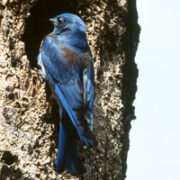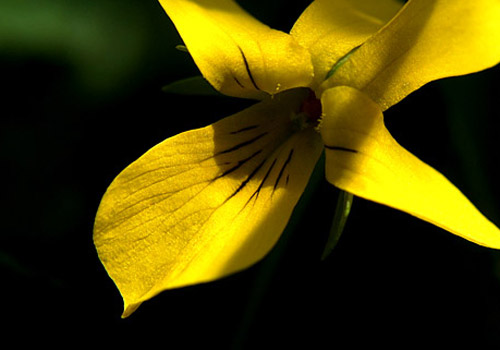Species at Risk
The Situation

Western bluebird, extirpated from Vancouver Island (photo by Don McPhee)
Garry Oak and associated ecosystems are home to more plant species than any other land-based ecosystem in coastal British Columbia. Many of these species occur nowhere else in Canada. At this time, because so much habitat has been lost or degraded, approximately 100 species of plants, mammals, reptiles, birds, butterflies and other insects are officially listed as “at risk” in these ecosystems. Several species have already been eliminated in British Columbia, including fragrant popcornflower (Plagiobothrys figuratus), the Georgia Depression population of the western bluebird (Sialia mexicana), and the island large marble butterfly (Euchloe ausonides insulanus). Collectively, Garry Oak and associated ecosystems are among the most endangered in Canada — less than 5% of the original habitat remains in a near-natural condition. It is important to retain the components of these ecosystems as much as possible in order to preserve their integrity and biological diversity.

Yellow montane violet, Viola praemorsa (photo by Tim Ennis)
What are Species at Risk?
A plant or animal is said to be “at risk” when it is deemed to be in danger of disappearing from the wild. In Canada, assessments are made at both federal and provincial government levels. These assessments are based on biological factors and use rigorous assessment criteria, followed by classification into categories based on level of risk.
A designation of “at risk” identifies species that require immediate help from land managers, such as protection of habitat essential to the survival of the species. These designations may also initiate recovery planning focused on the needs of the particular species at risk.
The Committee on the Status of Endangered Wildlife in Canada (COSEWIC) determines the national status of wild Canadian species, subspecies and separate populations suspected of being at risk. COSEWIC bases its decisions on the best up-to-date scientific information available. All native mammals, birds, reptiles, amphibians, fish, molluscs, lepidopterans (butterflies and moths), vascular plants, mosses and lichens are included in its current mandate.
Three lists are maintained:
- Species at Risk: species designated in the following categories
- Extinct: no longer exists
- Extirpated: no longer present in the wild in Canada, but exists elsewhere in the wild
- Endangered: facing imminent extirpation or extinction
- Threatened: likely to become an endangered species if nothing is done to reverse the factors leading to its extirpation or extinction
- Special Concern (Vulnerable): particularly sensitive to human activities or natural events, but not including extirpated, endangered, or threatened species
- Not at Risk: species that have been evaluated and found to be not at risk
- Data Deficient: species for which there is insufficient scientific information to support a risk or not at risk designation.
Once a species has been designated “at risk” by COSEWIC, it is considered for addition to the federal List of Wildlife Species at Risk (Schedule 1). Once a species has been listed, a recovery planning or management plan must be prepared within a designated period of time.
Extirpated, Endangered, and Threatened species on the List of Wildlife Species at Risk (Schedule 1) and their residences have:
- Immediate protection on federal lands (except for those species in the territories that go through the safety net process described below)
- Immediate protection if they are an aquatic species
- Immediate protection if they are a migratory bird
- Protection through a safety net process if they are any other species in a province or territory.
For more information, see Questions and Answers below or the Species at Risk Act Public Registry.
At the provincial level, specialists at the BC Conservation Data Centre, in cooperation with scientists and experts throughout the province, have identified British Columbia’s most vulnerable vertebrate animals, vascular plants and natural plant communities. Invertebrate animals, mosses and lichens are currently being identified. Each of these rare and endangered species and plant communities is assigned a global and provincial conservation status rank according to an objective set of criteria established by The Nature Conservancy (USA). They are also placed on provincial red and blue lists, according to the degree of rarity.

Golden paintbrush, an endangered Garry Oak ecosystems plant (photo by Chris Junck)
- Red List — Includes any indigenous species or subspecies that have, or are candidates for extirpated, endangered, or threatened status in British Columbia. Extirpated taxa no longer exist in the wild in British Columbia, but do occur elsewhere. Endangered taxa are facing imminent extirpation or extinction. Threatened taxa are likely to become endangered if limiting factors are not reversed. Not all Red-listed taxa will necessarily become formally designated. Placing taxa on these lists flags them as being at risk and requiring investigation.
- Blue list — Includes any indigenous species or subspecies considered to be Vulnerable in British Columbia. Vulnerable taxa are of special concern because of characteristics that make them particularly sensitive to human activities or natural events. Blue-listed taxa are at risk, but are not extirpated, endangered or threatened.
Species at Risk & You
If you live within the range of Garry Oak ecosystems, there is a chance that there may be rare or endangered plants or animals on your property. These species are often very difficult to identify. There are experts who can help you identify these species before you undertake any restoration or development of your land.
Legislation & Policy
- What is the legal basis for the protection of species at risk found in Garry Oak ecosystems?
- What federal and provincial government agencies are responsible for the protection of species at risk and recovery of Garry Oak ecosystems?
- What is a “species at risk” and how is species status assessed?
- What is an “ecosystem at risk”? What is a “multi-species approach” to planning for the recovery of species at risk?
- What are the legal tools and processes for protecting and recovering species at risk in Garry Oak ecosystems that have been identified and listed under the Species at Risk Act?
- What incentives are available for the protection of species at risk in Garry Oak ecosystems?
- I own private land in southwestern British Columbia that may be Garry Oak habitat. How does species at risk legislation affect me?
Read the answers: Questions & Answers: Legislation and Policy for the Protection of Garry Oak Ecosystems (2006)
Recovery Strategies
A recovery strategy is a planning document that identifies what needs to be done to stop or reverse the decline of an endangered, threatened or extirpated species. It sets goals and objectives and outlines activities to be undertaken. Detailed planning is done at the subsequent action plan stage.
Although recovery planning in Canada has historically taken a species-by-species approach, national initiatives have recognized the importance of incorporating a wider scope in recovery planning than single species recovery. The federal Species at Risk Act (SARA) permits ecosystem-level planning for recovery of species at risk under appropriate circumstances.
Soon after its inception, GOERT prepared an ecosystem-level strategy titled Recovery Strategy for Garry Oak and Associated Ecosystems and their Associated Species at Risk in Canada, 2001–2006 (2002). While this strategy addresses recovery of the full diversity of Garry Oak and associated ecosystems along with the essential ecosystem characteristics that sustain them, it also addresses the needs of individual species.
GOERT has prepared strategies for the recovery of species at risk within Garry Oak woodlands, maritime meadows and vernal pools. They can be viewed at the Species at Risk Act Public Registry website:
- Recovery Strategy for Multi-Species at Risk in Garry Oak Woodlands in Canada (2006)
- Recovery Strategy for Multi-Species at Risk in Maritime Meadows associated with Garry Oak Ecosystems in Canada (2006)
- Recovery Strategy for Multi-Species at Risk in Vernal Pools and other Ephemeral Wet Areas Associated with Garry Oak Ecosystems in Canada (2006)
- Recovery Strategy for Rigid Apple Moss (2006)